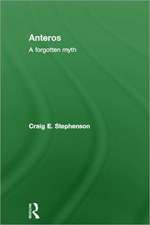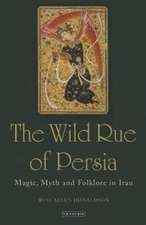Urban Legends: A Collection of International Tall Tales and Terrors
Autor Gillian Bennett, Paul Smithen Limba Engleză Hardback – 29 apr 2007 – vârsta până la 17 ani
Preț: 372.73 lei
Preț vechi: 642.35 lei
-42% Nou
Puncte Express: 559
Preț estimativ în valută:
71.32€ • 74.65$ • 59.36£
71.32€ • 74.65$ • 59.36£
Carte tipărită la comandă
Livrare economică 31 martie-14 aprilie
Preluare comenzi: 021 569.72.76
Specificații
ISBN-13: 9780313339523
ISBN-10: 031333952X
Pagini: 376
Dimensiuni: 178 x 254 x 30 mm
Greutate: 0.92 kg
Editura: Bloomsbury Publishing
Colecția Greenwood
Locul publicării:New York, United States
ISBN-10: 031333952X
Pagini: 376
Dimensiuni: 178 x 254 x 30 mm
Greutate: 0.92 kg
Editura: Bloomsbury Publishing
Colecția Greenwood
Locul publicării:New York, United States
Notă biografică
Gillian Bennett is an independent scholar and the author of numerous works on ghost stories and urban legends. She has edited several works with Paul Smith and is also the author of Alas, Poor Ghost!: Traditions of Belief in Story and Discourse (1999), and Bodies: Sex, Violence, Disease, and Death in Contemporary Legend (2005).Paul Smith is Professor of Folklore at Memorial University of Newfoundland. His work encompasses contemporary legend, traditional drama, and folklore and popular literature. With Gillian Bennett, he has edited numerous works, including Contemporary Legend: A Folklore Bibliography (1993), and Contemporary Legend: A Reader (1996).
Recenzii
This entertaining guide is suitable for a wide range of audiences and amply demonstrates for the students that academic scholarship can be quite fun.
This collection describes urban legends in nine themed chapters: city life; horror; accidents, fate, and chance; the body and disease; animals; sex and nudity; merchandise; murder, death, and burial; and the supernatural. The authors compiled stories from friends and colleagues, newspapers and magazines, folklore books and journals, compilations, and correspondence. Interpretation of the legends or explanations for their popularity is avoided, as is discussion of whether they are true. Instead, background on the story and examples of them are given. Criteria for urban legends include presence of a narrative structure, outrageous content in an everyday setting, anonymous origins, and multiple examples. The four indexes are organized by title, examples in film and literature, and subject.
Studying urban legends may encourage students to think critically about information found in questionable resources such as the Web. Chapters include City Life beginning with the standard, Alligators in the Sewers, Horror, Accidents, Fate, and Chance, The Body and Diseases, Animals, Sex and Nudity, Merchandise, Murder, Death, and Burial and The Supernatural. Chapters have brief introductions and each legend is discussed with an example and suggestions for further reading. Appendixes include A Provisional List of Urban Legends in Film and Literature, further reading and online resources, the Urban Legend Title Index and three indexes, Urban Legends on Film, in Literature and a subject index. This provides excellent examples of carefully researched and reported information about tall tales.
Bennett and Smith's Urban Legends is a worthy follow-up to their earlier compilations and deserves a place in any reference collection on the subject..The on-line resources listed are crucial in this electronic age and go well beyond the standard (and invaluable) sources such as Snopes.com or About.com's urban legends Web site.
This collection describes urban legends in nine themed chapters: city life; horror; accidents, fate, and chance; the body and disease; animals; sex and nudity; merchandise; murder, death, and burial; and the supernatural. The authors compiled stories from friends and colleagues, newspapers and magazines, folklore books and journals, compilations, and correspondence. Interpretation of the legends or explanations for their popularity is avoided, as is discussion of whether they are true. Instead, background on the story and examples of them are given. Criteria for urban legends include presence of a narrative structure, outrageous content in an everyday setting, anonymous origins, and multiple examples. The four indexes are organized by title, examples in film and literature, and subject.
Studying urban legends may encourage students to think critically about information found in questionable resources such as the Web. Chapters include City Life beginning with the standard, Alligators in the Sewers, Horror, Accidents, Fate, and Chance, The Body and Diseases, Animals, Sex and Nudity, Merchandise, Murder, Death, and Burial and The Supernatural. Chapters have brief introductions and each legend is discussed with an example and suggestions for further reading. Appendixes include A Provisional List of Urban Legends in Film and Literature, further reading and online resources, the Urban Legend Title Index and three indexes, Urban Legends on Film, in Literature and a subject index. This provides excellent examples of carefully researched and reported information about tall tales.
Bennett and Smith's Urban Legends is a worthy follow-up to their earlier compilations and deserves a place in any reference collection on the subject..The on-line resources listed are crucial in this electronic age and go well beyond the standard (and invaluable) sources such as Snopes.com or About.com's urban legends Web site.









![Cult of the Black Virgin [Paperback]](https://i0.books-express.ro/bt/9781630512705/cult-of-the-black-virgin-paperback.jpg)



